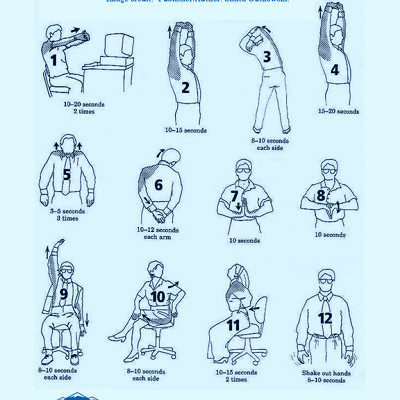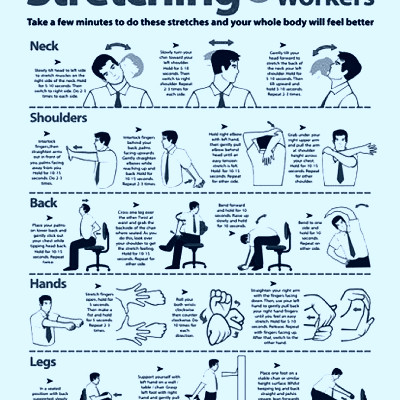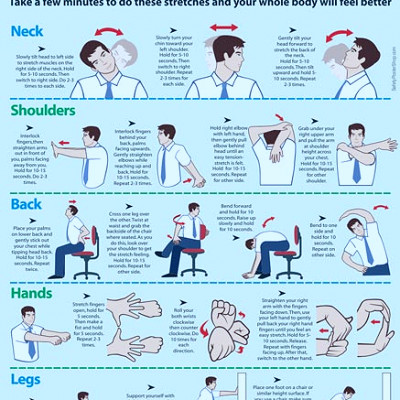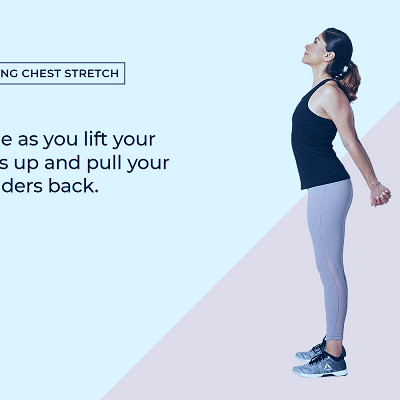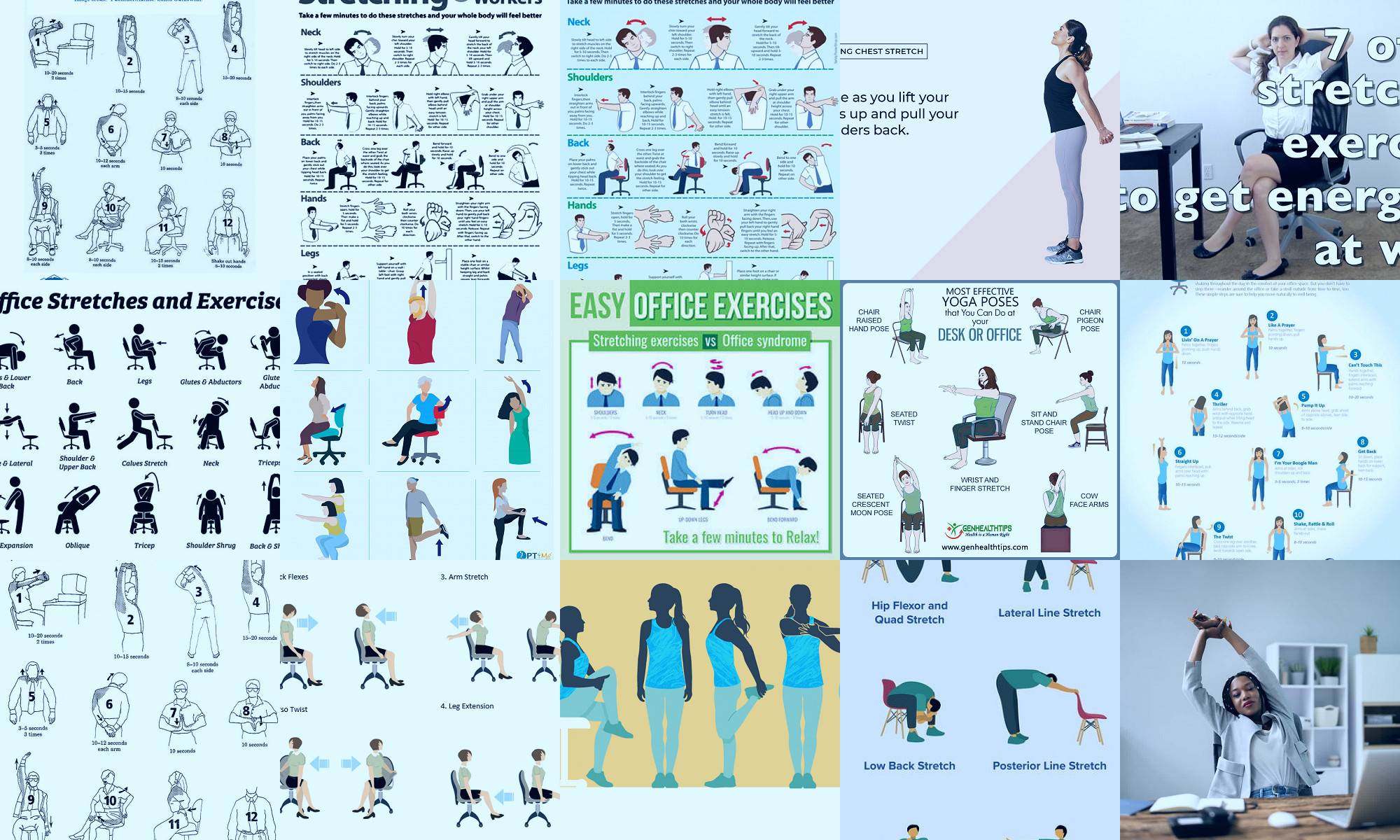 Jarlat Maletych/Shutterstock
Jarlat Maletych/Shutterstock
Features
Importance of Stretching
In the fast-paced work environment of modern offices, it's easy to forget the importance of regular physical activity. Stretching exercises are a simple and effective way to combat the negative effects of sitting for long periods, such as muscle stiffness and tension, poor blood circulation, and lower back pain.
Neck Stretches
Start by gently tilting your head towards your shoulder, holding for a few seconds, then repeating on the other side. This helps to reduce the tension in your neck muscles, a common issue for office workers.
Shoulder Rolls
Raise your shoulders up towards your ears, then roll them backwards in a circular motion. This exercise helps to relieve shoulder and upper back tension caused by hunching over a computer.
Wrist Stretch
Extend your arm in front of you, palm facing upwards, and gently pull your fingers towards you with your other hand. This stretch is beneficial for those who spend a lot of time typing.
Chest Opener
Stand up, interlace your fingers behind your back and lift your arms while keeping your back straight. This exercise can help to correct the forward-leaning posture that is common in office workers.
Hip Flexor Stretch
Stand up and take a large step forward with one foot, then bend the front knee while keeping the back leg straight. This can help to relieve tight hip flexors, a common issue for people who sit a lot.
Seated Twist
While seated, twist your upper body towards one side, using your armrest for support. This can help to relieve tension in the lower back.
Ankle Rotations
While seated, lift one foot off the ground and rotate your ankle clockwise and then counter-clockwise. This helps to improve circulation in your lower legs.
Standing Quad Stretch
Stand up, bend one knee, and grab your ankle. Pull your heel towards your buttock to feel a stretch in the front of your thigh. This exercise can help to counteract the effects of sitting all day.
Hamstring Stretch
While seated, extend one leg in front of you with your heel on the ground and your toes pointing upwards. Lean forward slightly to feel a stretch in the back of your thigh.
Eye Exercise
Every 20 minutes, look away from your screen and focus on a distant object for 20 seconds. This can help to prevent eye strain.
Deep Breathing
Take a few moments to close your eyes and focus on your breath. Inhale deeply, hold for a moment, then exhale slowly. This can help to reduce stress and promote relaxation.
The Importance of Regular Breaks
Remember to take regular breaks from your desk, even if it's just a quick walk to the water cooler. This can help to improve your overall health and productivity.
Desk Ergonomics
Ensure your workspace is set up correctly, with your monitor at eye level and your chair at the correct height. This can help to prevent strain and injury.
The Benefits of Exercise
Regular physical activity can help to improve your mood, increase your energy levels, and reduce your risk of chronic diseases.
The Role of Diet
A healthy diet is also important for maintaining your health and wellbeing. Try to include plenty of fruits, vegetables, whole grains, lean proteins, and healthy fats in your meals.
Hydration
Drinking enough water throughout the day can help to prevent dehydration, which can lead to fatigue, headaches, and difficulty concentrating.
The Power of Mindfulness
Taking a few minutes each day to practice mindfulness can help to reduce stress and improve your mental wellbeing.
The Importance of Sleep
Getting enough sleep is crucial for your overall health and productivity. Aim for 7-9 hours of sleep per night.
Conclusion
Incorporating these simple exercises and habits into your daily routine can help to improve your health and wellbeing, and make your workday more enjoyable. Remember, your health is your most valuable asset, so take care of it!
Interesting notes and facts
1. The Neck Release: A Simple, yet Effective Desk StretchWhether you're hunched over a report or craning your neck towards a screen, office work can put a strain on your neck. The Neck Release exercise helps to alleviate this stress. It involves gently lowering your ear towards your shoulder and holding the position for about 10-15 seconds. Repeat this on both sides for maximum relief.
2. Wrist and Forearm Opener: A Stretch for Computer Users
Do you spend hours typing away at a keyboard? The Wrist and Forearm Opener is a stretch designed for you. Extend your arm with your palm up, then gently pull your fingers down with your other hand. Hold for about 10 seconds before switching arms.
3. The Seated Spinal Twist: Realigning Your Posture
The Seated Spinal Twist is a fantastic stretch for realigning your spine and improving posture. While seated, cross your right leg over your left, then gently twist your torso to the right. Hold for 10-15 seconds, then repeat on the other side.
4. Shoulder Shrugs: A Quick Tension Reliever
Shoulder Shrugs are quick and effective at relieving tension. Simply raise your shoulders up towards your ears, hold for a few seconds, and then release. Repeat this several times throughout the day to keep your shoulders loose and tension-free.
5. The Chest Opener: A Stretch for Better Breathing
Office work often makes us hunch over, constricting our chest and limiting breathing. The Chest Opener stretch can help. Stand straight, interlace your fingers behind your back and gently lift your arms until you feel a stretch in your chest. Hold for a few seconds, then release.
6. Seated Hip Stretch: A Remedy for Sitting Too Long
Sitting for long periods can tighten your hips. The Seated Hip Stretch is a great remedy. While seated, place your right ankle on your left knee and gently push down on your right knee. Hold for about 15 seconds, then switch sides.
7. The Back-and-Forth Neck Stretch: A Movement-Based Relief
The Back-and-Forth Neck Stretch involves gently tilting your head back and forth, left to right. This simple movement can provide immense relief from stiff necks caused by static office work.
8. Standing Hamstring Stretch: A Break for Your Legs
Take a break from sitting with the Standing Hamstring Stretch. Stand up, bend at the waist, and try to touch your toes. Hold for about 10 seconds before slowly rolling back up. This stretch not only targets your hamstrings but also your back and neck.
9. The Office Yoga Pose: A Full Body Stretch
Yes, you can do yoga in the office! A simple pose like the Mountain Pose can stretch your entire body. Stand straight, raise your arms overhead, and reach for the sky. Hold for a few breaths before releasing.
10. Eagle Arms: A Stretch for Shoulder and Upper Back Tension
Eagle Arms is a stretch that targets shoulder and upper back tension. Cross your arms, then bend at the elbows and try to touch your palms together. Hold for about 10 seconds, then switch the cross of your arms.
Vocabulary
- Stretching – A form of physical exercise in which a specific muscle or tendon is deliberately flexed or stretched to improve the muscle's elasticity and achieve comfortable muscle tone.
- Office Workers – Employees who perform administrative or clerical tasks in an office environment.
- Posture – The position in which someone holds their body when standing or sitting.
- Ergonomics – The study of people's efficiency in their working environment.
- Sedentary Lifestyle – A type of lifestyle with little or no physical activity.
- Neck Stretch – A stretching exercise that targets the muscles in the neck.
- Shoulder Shrug – An exercise that strengthens and stretches the shoulder muscles.
- Trunk Twist – A stretch that targets the lower back and abdominal muscles.
- Seated Forward Bend – A stretching exercise that targets the lower back and hamstrings.
- Hamstrings – The three muscles at the back of the thigh that affect hip and knee movement.
- Wrist Stretch – A stretching exercise that targets the muscles in the wrist.
- Flexibility – The quality of bending easily without breaking.
- Muscle Elasticity – The ability of a muscle to return to its original length after being stretched.
- Muscle Tone – The state of tension or resistance to stretch in resting muscles.
- Desk Exercises – Exercises that can be done while sitting at a desk.
- Physical Activity – Any body movement that works your muscles and requires more energy than resting.
- Lumbar Region – The lower part of the spine between the diaphragm and the sacrum.
- Cervical Region – The upper part of the spine, also known as the neck.
- Thoracic Region – The middle part of the spine, also known as the upper back.
- Spinal Mobility – The degree to which individual vertebral segments move within the spinal column.
- Muscle Endurance – The ability of a muscle or group of muscles to perform repeated contractions against a load for an extended period of time.
- Repetitive Strain Injury – A condition in which the prolonged performance of repetitive actions, typically with the hands, causes pain or impairment of function in the muscles and nerves.
- Carpal Tunnel Syndrome – A painful condition of the hand and fingers caused by compression of a major nerve where it passes over the carpal bones.
- Physical Fitness – A state of health and well-being and, more specifically, the ability to perform aspects of sports, occupations and daily activities.
- Musculoskeletal Disorders – Injuries or pain in the body's joints, ligaments, muscles, nerves, tendons, and structures that support limbs, neck and back.
- Occupational Health – A field of healthcare that focuses on the well-being and safety of employees in the workplace.
- Workstation – A place where work of a particular type is done, typically one that is fully equipped for a particular type of work.
- Office Ergonomics – The process of designing or arranging workplaces, products and systems so that they fit the people who use them in an office.
- Stretch Breaks – Periodic breaks during the workday to perform stretching exercises to reduce muscle stress and fatigue.
- Joint Mobility – The degree to which an individual joint or group of joints can move before being restricted by surrounding tissues.
- Muscle Strength – The amount of force a muscle can produce with a single maximal effort.
- Dynamic Stretching – A form of stretching beneficial in sports utilizing momentum from form, and the momentum from static-active stretching strength, in an effort to propel the muscle into an extended range of motion.
- Static Stretching – A type of stretching exercise where a specific position is held with the muscle on tension for a certain period of time.
- Chair Yoga – A gentle form of yoga that can be done sitting on a chair or standing on the ground while using the chair for support.
- Deep Breathing – A type of breathing that slows the heartbeat and can lower or stabilize blood pressure.
- Mindfulness – The quality or state of being conscious or aware of something, especially present moment.
- Health and Wellness – An active process of becoming aware of and making choices toward a healthy and fulfilling life.
- Physical Health – A state of physical well-being in which a person is physically fit to perform their daily activities without restrictions.
- Mental Health – A person's condition with regard to their psychological and emotional well-being.
- Eye Strain – A condition characterized by symptoms such as fatigue, pain in or around the eyes, blurred vision, headache and occasional double vision.
- Body Mechanics – The use of one's body to produce motion that is safe, energy conserving, and anatomically and physiologically efficient.
- Occupational Therapy – A form of therapy for those recuperating from physical or mental illness that encourages rehabilitation through the performance of activities required in daily
